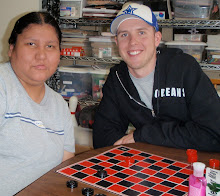Reflection
The process by which service learning is enhanced through experiential sharing and awareness.
Why Reflect?
The purpose of reflection is to allow participants the opportunity to share the variety of perspectives that are derived from the same service experience.
Reflecting on the efforts, challenges, and rewards of service not only solidifies their impact, it aids in the realization of what is actually being learned and accomplished.
Ideas for Reflection Facilitation
· M&M reflection: Participants grab a handful of M&M’s without being informed the details of the reflection activity. The facilitator will choose a specific question to correlate with a certain color of M&M. The questions could vary in intensity from “How did you feel about today?” to “Who is an inspirational role model in your life and why?” One by one, participants will answer questions if s/he has matching M&M color.
· Balloon Faces to represent emotions: Blow up one balloon for each participant. On each balloon, have the draw a facial expression that expresses their current emmotion. Use this to identify feelings.
· Symbols and Dichos: The facilitator passes out one sheetof paper to each person. The participants will draw either a symbol or dicho (a word, phrase, or quote) that describes them nad then share with either one other person or the entire group.
· Warm fuzzies: Use something (envelope or paper bag) for each participant and put their names on them. Have these available all week long, people can put in notes of encouragement, thanks and recognition “warm fuzzies.”
· Brown Bag skits: Divide group into 3 or 4 smaller groups and assign each group to a brown bag full or random items (could include: a toothbrush, bandana, eating utensils, strange articles of clothing, an umbrella, a soda can, toilet paper). Allow 10-15 minutes to prepare a skit depicting either an event that occurred that day or their reaction to something that has occurred in group activities or the service experience.
· Roses and Thorns: The facilitator begins a discussion by talking about the “thorns” of the day. Thorns could be something negative that happened or something that you wish would have happened, for example “I wish we could have finished building the walls”. After, the facilitator starts the discussion of the “Roses” to leave on a positive note.
· Group Journal: This is a variation of a personal journal; however, people from the group take turns writing in it. You can include funny things that happened or personal stories that you encountered during your volunteering experience.
· Posters and pictures: Upon returning from your volunteer project, you can create posters to display pictures. Also on these, you could include how many people you served and to what capacity. For example, “We helped 35 kids learn how to read” or “We planted 1100 trees in the wetland.” It helps participants to realize the extent of their service when concrete numbers are attached.
· Prioritize: The facilitator puts words or phrases on little slips of paper and distributes them to all participants. Each participant should have the same slips in front of him/her. (Recommended 5-10 words or phrases). For example, love, family, security, wealth, religion, friendship, etc..have all been used. Have each participant take a few minutes to arrange their priorities in the order they feel most important to least important. Then everyone either tells why they have them in that order OR everyone tells their highest and lowest priority. It creates more insight into the participants that low risk activities, but most people are willing to share.
· Yarn Spider Web: Use a ball of yarn and have participants stand in a circle and identify a goal they have for the project (pre-reflection) or the facilitator should ask a question that each person has to respond to (reflection). When they share their answers, toss the yarn to another person until everyone has been able to share and create a “spider web”. Cut the string and tie it to wrist; this helps them remember their goal or answer as they move throughout the rest of their service experience. The bracelet will represent unity between the groups, volunteering as a team.
· 4 Corners: Participants respond to questions asked by facilitator by moving to one of the appropriated corners. Strong agree, Agree, Disagree, and strongly disagree. This exercise should be done without speaking. After the exercise is complete, facilitator leads a short debriefing.
· Letter to self: Distribute paper and envelopes to participants and ask them to write a letter to themselves. In this letter they should detail how they felt during their volunteer experience and what they want to remember in the future. The facilitator should collect sealed and addressed envelopes and mail them out a few months following the experience.
· What will you remember?: In a circle discussion, ask participants to answer the questions: “What will you remember from this week in 3 months? In 5 years? In 25 years?”
· Personal Maps: Facilitator gives each person a flip chart paper, markers, crayons, glue and/or tape. Encourage group to create their own personal map (words, symbols, colors etc). The following questions are to be used as guidelines only: they shouldn’t be answered fully or in any specific order. This activity should be done I silence.
*Who are you? What defines you? What/ who is important to you?
*Describe the community you were raised in.
*What and/or who have been factors (negative/positive) while you were making decision to become involved in service?
*How did you get here from there? We are all on a journey or personal change, exploration, growth and development; where are you at this point in your journey?





